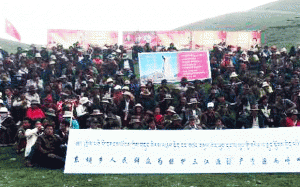Chinese mining operations have again prompted protest by Tibetans concerned about the degradation of local health and environmental integrity. The protest, which occurred on August 5 and 6 in Qinghai Province’s south-western Nangchen County, contributes to growing criticism by Tibetans and environmentalists around the world of China’s intensive natural resource exploitation in Tibet’s interior.
The protest was set in motion when Tibetan residents of Nangchen County discovered that a coal-mining company active in the region was planning to drastically expand three of its four local operations. Two days later, over one hundred protesters gathered at the site of one of the mines near Gongshung Ruchen village; there they decried any increase in mining activity and displayed banners with pro-environment quotations from Chinese leaders such as President Xi Jinping. Fearing further mining-related corrosion of the local ecosystem and public health, a number of the protesters “became emotional and wept in a state of desperation,” according to a source from the protest.
Local authorities, who quickly arrived at the site of the protest, listened to the Tibetans’ grievances, assuring them that their concerns would be raised at higher levels of government and demanding that the protesters leave the area.
Mining operations in the Nangchen region began in 2000, and have since expanded to four locations: Gongshung Ruchen, Menmar Norbuma, Droglung Okar, and Ahge Kyilung. Protests against the destructive effects of heavy mining on environmental and public health have not been limited to Nangchen County, however.
In early June, 27 Tibetan protesters in eastern Qinghai’s Chabcha (Chinese: Gonghe) County were arrested for attempting to block a white marble-mining operation that was continuing past the expiration of its lease; later that month, a group of Tibetan women protesting against a copper-mining operation in Yunnan’s Dechen (Chinese: Diqing) County were beaten and detained.
China is heavily reliant upon coal, which accounts for 70% of the nation’s energy. As pollution and resource depletion has increased in the country’s east over the last decade, intensive natural resource exploitation has gradually moved westward to the less densely-populated regions of the nation’s interior. Though Chinese leaders are increasingly paying attention to environmental regulations, according to Zhong Lijin at the World Resources Institute, regulations on coal mining remain particularly weak, leaving fragile ecosystems and local public health both at risk.






 Print
Print Email
Email